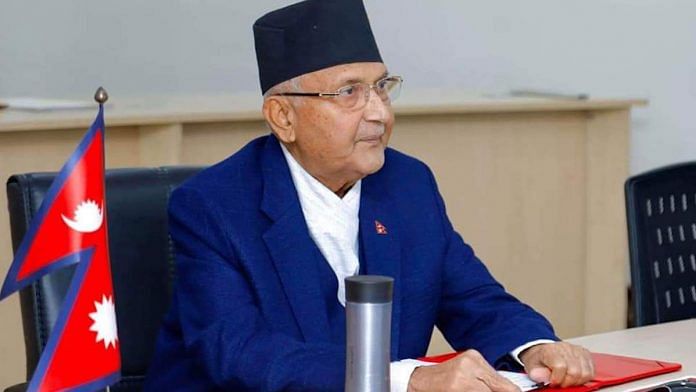New Delhi: Nepal could undergo a fresh round of elections after Prime Minister K.P. Sharma Oli dissolved the existing Parliament, in which his coalition of communist parties held a two-third majority.
In episode 645 of ‘Cut The Clutter’, Shekhar Gupta takes a closer look at the reasons behind the crisis, Nepal’s complex political system and its legacy of instability.
Gupta noted that India has integrated ties in terms of culture, religion, strategic interests and politics with Nepal, with which it also shares a large land border. Despite going through some ups and downs, the India-Nepal relationship has been strong.
Apart from this, the military ties between both the countries are also strong as the Indian and Nepalese army chiefs are honorary generals in each other’s forces.
However, Nepalese elites have always had the sense that India exercises undue influence over their internal affairs, said Gupta.
Nepal’s democratic politicians in the past, going back to the days of the Nepali Congress, have been very impressed and influenced by the Indian National Congress politicians and Indian socialists. Thus, the insecurities among royal families in Nepal and the governments with respect to India has been a common phenomenon, noted Gupta.
Nepal PM K.P. Sharma Oli has now asked for the dissolution of the Assembly and fresh elections. However, if within two-and-a-half year of an election, one can still form the government; dissolution of the assembly is not allowed by the country’s constitution.
The call has to be taken by the President. However, the President of Nepal is close to Oli and it has become a tradition in the subcontinent that presidents are ceremonial and can sign on anything that the government tells them to do, said Gupta.
Also read: Nepal ruling party NCP likely to announce split tomorrow, Oli & Prachanda to ‘hold on to name’
How the govt in Nepal was formed
The current government is a coalition, which later became a single party — the Nepal Communist Party (NCP).
The NCP was formed in May 2018 with the coming together of the country’s two major Left parties — the Communist Party of Nepal (Unified Marxist–Leninist) led by Oli, and the Communist Party of Nepal (Maoist Centre), led by Pushpa Kamal Dahal, known as Prachanda.
In the 2018 election, nobody got a majority, but CPN (UML) and CPN (Maoist Centre) came together and formed an alliance, which also included small communist parties, and got a two-third majority in the House (175 out of 275 seats).
Meanwhile, Nepal’s population also consists of 30 per cent of Madhesis — people of Indian origin who migrated to the country in the past and live in districts along the Indian borders. The Madhesis wanted a larger representation in Nepal’s Parliament and they wanted certain things added to the country’s constitution, which the majority government was not willing to do.
The third party in the Nepalese political system is the Madhesi party called Federal Socialist Forum, Nepal, which merged with Naya Shakti Party in Nepal, headed by Baburam Bhattarai who got his college education in India. The merger was named Samajwadi party. The SP again merged with the Rashtriya Janata Party and was now called Janata Samajwadi Party.
Also read: Nepal, China in ‘new era’ of strategic ties, vow to strengthen trans-Himalayan connectivity
Nepal’s complex political system
Nepal follows both ‘first past the post’ and ‘party proportional representation’ political system. Of the 275 seats that go to the polls in Nepal Parliament, 165 seats are elected by ‘first past the post’ where each party nominates a candidate. Each party also gets a second vote for the ‘party proportional representation’ system.
So, 165 of the MPs get elected directly through first past the post, but 100 are left aside that are then divided by all the parties in proportion to the votes they have got. Nobody got the majority in 2018 elections, so Prachanda and Oli decided to come together and the two-third majority came into being.
In all this time, Nepal has never had political stability. In 58 years, it had 49 prime ministers. It has also seen many political systems — pure monarchy, elected government with monarchy, panchayat system, constitutional monarchy, and then a democratic republic but ruled by communist parties.
Some people like to say that Nepal is the fifth communist country after China, North Korea, Cuba, Laos, Vietnam, but Nepal is not strictly a communist country.
It’s a communist country only to the extent that communist parties are in power, Gupta said. Underlying all of this are various complications of a very cluttered electoral system, he added.
When Prachanda and Oli came together, they had a deal to exchange prime ministership halfway through the tenure but it got leaked.
So another deal was offered by Oli that he would stay as prime minister, but he will give up his position as the president of the party. But soon enough, it also became evident that Oli was not going to keep that promise.
Then he played the nationalist trump card when he released political maps of Nepal that included disputed Indian land, which was his way to create a distraction from his government falling apart, noted Gupta.
But ultimately Oli had to dissolve the assembly as a last resort.
Watch the latest episode of CTC here:



